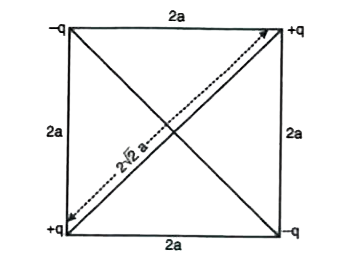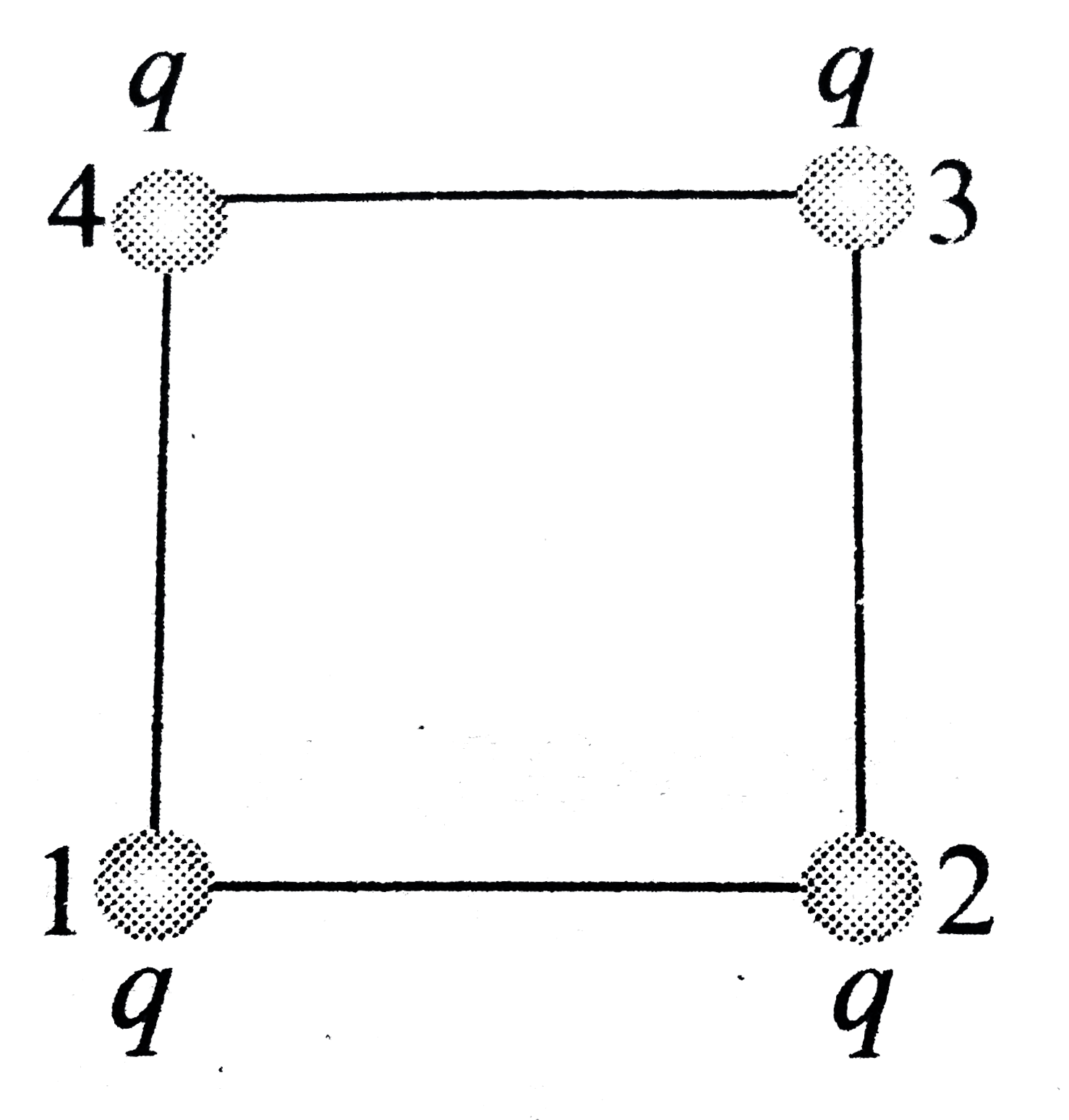Two identical positive charges are placed at the diagonally opposite corners of a square . Two more identical but negative charges are placed at the other two corners. What is the work done in putting all the charges together at the centre . If q is the magnitude of each charge and 2a is the length of each of the square ?
√2q28πε0a
4+q28πε0a
q2(4−√2)8πε0a
q2(2−√2)8πε0a
The correct Answer is:C
W=U2−U1,U2=0 is P.E at centre
U1 = P.E of all in original state

Now
U1=[14πε0−q22a−q22a−q22a+q22a+q2√2.2a+q22√2.a]
=−q2.(4−√2)8πε0a
∴ W=U2−U1=q2(4−√2)8πε0a
Topper's Solved these Questions
- ELECTROSTATICSBOOK - MODERN PUBLICATIONCHAPTER - ELECTROSTATICSEXERCISE - LEVEL-III
23 Videos
- ELECTROSTATICSBOOK - MODERN PUBLICATIONCHAPTER - ELECTROSTATICSEXERCISE - RECENT COMPETITIVE QUESTIONS
39 Videos
- ELECTROSTATICSBOOK - MODERN PUBLICATIONCHAPTER - ELECTROSTATICSEXERCISE - RECENT COMPETITIVE QUESTIONS
39 Videos
- ELECTRONS & PHOTONSBOOK - MODERN PUBLICATIONCHAPTER - ELECTRONS & PHOTONSEXERCISE - RECENT COMPETITIVE QUESTIONS
20 Videos
- GRAVITATIONBOOK - MODERN PUBLICATIONCHAPTER - GRAVITATIONEXERCISE - Recent Competitive Questions
8 Videos
Similar Questions
Two identical positive charges are placed at the diagonally opposite corners of a square and two more identical but negative charges are placed at the remaining two corners. What is the work done in putting all charges together at the centre if q is the magnitude of each charge and 2a is the length of each side of the square?
View SolutionFour identical point charges q are placed at four corners of a square of side a. Find the potential energy of the charge system.
 .
.
View Solution
Knowledge Check
At each corner of an equilateral triangle identical charges are placed. Then at the centre of the triangle
Athe resultant electric intensity is zeroBthe net potential is zeroCboth electric intensity and potential are zeroDneither electric intensity nor potential are zeroA charges Q is placed at each of the two opposite corners of a square. A charge q is placed to each of the other two corners. If the resultant force on each charge q is zero, then
Aq=√2QBq=−√2QCq=2√2QDq=−2√2Q
Four identical point charges q are placed at four corners of a square of side a. Find the potential energy of the charge system.
 .
.
View SolutionA charges Q is placed at each of the two opposite corners of a square. A charge q is placed to each of the other two corners. If the resultant force on each charge q is zero, then
View SolutionA charges Q is placed at each of the two opposite corners of a square. A charge q is placed to each of the other two corners. If the resultant force on each charge q is zero, then
View SolutionTwo equal point charges Q=+√2μC are placed at each of the two opposite corners of a square and equal point charges q at each of the other two corners. What must be the value of q so that the resultant force on Q is zero?
View SolutionTwo equal point charges Q=+√2μC are placed at each of the two opposite corners of a square and equal point charges q at each of the other two corners. What must be the value of q so that the resultant force on Q is zero?
View SolutionA charge Q is placed at each of the two opposite corners of a square of side a.A charge is placed at each of the other two corners. (a) if the reultant electrical force system of charges? What is the signification of its negative potential energy?
View Solution
